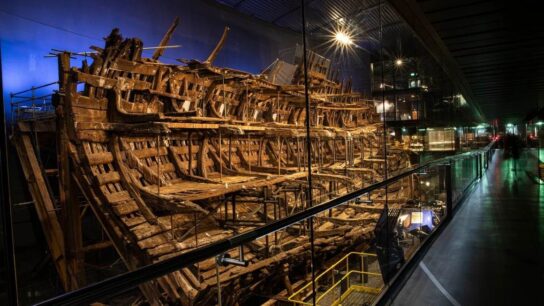Placement of ancient hidden lamps, skulls in cave in Israel suggests Roman-era practice of necromancy
A cave in Israel “has all the cultic and physical elements necessary to serve as a possible portal to the underworld” and was used for necromancy.

Archaeologists have discovered evidence of “a possible portal to the underworld,” where necromancy and other acts of cultic magic took place.
The find is located in a cave near Jerusalem that contains ancient skulls, lamps, coins, and artifacts that span thousands of years, reports a new study.
Te’omim Cave, located in the Jerusalem Hills of Israel, was a vibrant site of devotion for pagans in the late Roman period some 2,000 years ago, though it also contains artifacts that are at least two millenia older.
The cave is a source of both legends and real historical dramas, as its natural springwater and cavernous chambers have attracted visitors since the Bronze Age and even served as a hideout for Jewish rebels during the Bar Kokhba revolt in the 2nd century CE.
Since 2009, researchers have been excavating the site as part of a collaboration of the Martin (Szusz) Department of Land of Israel Studies and Archaeology at Bar-Ilan University and the Cave Research Center at the Hebrew University of Jerusalem.
During this time, the team has unearthed more than 120 intact oil lamps, along with weapons, coins, vessels, and three human craniums (skulls) with no signs of other skeletal remains.
The lamps and skulls, along with other artifacts, were found wedged into deep crevices in the cave that suggest ancient peoples deliberately arranged them for a ritual purpose.
Eitan Klein and Boaz Zissu, archaeologists with the Israel Antiquities Authority and Bar-Ilan University respectively, now “propose with due caution that necromancy ceremonies took place in the Te’omim Cave in the Late Roman period, and that the cave may have served as a local oracle (nekyomanteion) for this purpose,” according to a study published last week in the Harvard Theological Review.
The seemingly deliberate placement of artifacts in the cave hints that people performed necromancy ceremonies intended to raise the dead nearly 2,000 years ago, offering a new example of the so-called “archaeology of magic.”
“The Te’omim Cave in the Jerusalem hills has all the cultic and physical elements necessary to serve as a possible portal to the underworld,” the researchers said in the study. “Most of the objects discovered in hard-to-reach crevices in the Te’omim Cave, including the oil lamps, the ceramic and glass bowls and vessels, the axe head, and the daggers, were used in one way or another for sorcery and magic in caves perceived as possible portals to the underworld. Their purpose was to predict the future and conjure up the spirits of the dead.”
“Because more than 100 ceramic oil lamps but only three human skulls have been found so far in the Te’omim Cave, we hypothesize that the primary cultic ceremony focused on depositing oil lamps for chthonic forces, perhaps as part of rituals conducted in the cave to raise the dead and predict the future,” the team added.
This may sound like it was lifted from an Indiana Jones plotline, but Klein and Zissu outline a range of written sources and archeological discoveries to bolster their claim that the cave was a hotspot of magical rituals for the purpose of resurrection and divination.
“Identifying magical practices in the archaeological evidence is not simple,” the researchers said. “Magical practice is used in ritual acts that are undertaken, mainly by individuals, to achieve a desired effect.
Sometimes the practices should be carried out in a specific location or require the use of specific material culture. Therefore, to locate magic in the archaeological context, we must trace material evidence for those practices.”

To that end, the researchers note that Te’omim Cave contains a deep shaft and a flowing spring that accumulates in a rock-cut pool, which were features shared by many cave shrines in the Greco-Roman world.
Ancient peoples believed that these watery and subterranean spaces were portals in the underworld, and that cave shafts provided a path for the dead to rise, according to the study.
Klein and Zissu also provide numerous accounts of necromancy from the late Roman period, an era when this practice was controversial and ultimately outlawed by the emperor Constantius II in 357 CE.
They also point to ancient sources that link necromancy and other magical ritual acts to the items found in the cave, including skulls, lamps, and metals.
“Due to the archaeological context of the finds and their location inside the cave, we assume that the craniums were placed together with the oil lamps as part of a ritual of magic,” the team said.
“Examination of both the written sources and the archaeological finds may indicate the type of ritual that took place in the cave, involving the use and hiding of human craniums, lamps, and bowls, together with metal weapons and other artifacts dating to much earlier periods.”
While we may never know exactly what occurred in Te’omim Cave, the new study presents an eerie and evocative explanation for the weird discoveries that archaeologists have made within its storied walls.
The cave is an exemplary case study for “the developing discipline of the ‘archaeology of magic,’” which is focused on evidence for magical and supernatural practices in the past, according to the study.
“The findings and their specific archaeological contexts provide a better understanding of divination rites that were probably held in the cave and shed a more tangible light over the spells of the Greek and Demotic Magical Papyri,” the researchers concluded.




